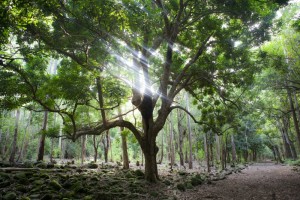The Indian Ocean island of Mauritius, just a four-hour flight from Johannesburg, has long been the beach-seeking vacationer’s dream destination. The icing-sugar sand, dotted with shaded loungers and edged with swaying palm trees, warm, clear water, championship golf courses and affordable resorts make an attractive all-round package, drawing visitors from around the world to this small slice of tropical paradise.
However, Mauritius has a lot to offer beyond its brochure-perfect beaches, a fact which most tourists don’t discover, confined to their all-inclusive seaside resorts. The island has a fascinating history, a rich culinary culture, a host of adventure activities away from the beaches and some wonderful off-the-beaten track places to stay.
This guide will inspire you to leave your resort – or even stay somewhere without a buffet in sight – on your next trip to Mauritius.
How to explore Mauritius through food
Mauritian cuisine has evolved over 250 years and draws influences from France, Africa, India and China to produce incredible gastronomic diversity. On one tiny island you’ll find French haute cuisine, curries, dim sum and spicy Creole stews.
Starting on the street, Mauritius has fantastic street food, which is cheap, tasty and found all over the island, at stalls, markets and on the backs of motorbikes – and always offered with a hefty dose of chilli. Some favorite local snacks include gâteau piments (chilli bites), pickled fruits (Mauritians swear by these for a hangover cure), Indian samosas and rotis filled with curry and deep-fried eggplant fritters. In Chinatown, an area in the capital of Port Louis, you’ll find vendors selling bowls of fried noodles topped with spring onions as well as dumplings in fish broth. While you’re in Chinatown, head to First Restaurant to taste their extensive selection of daily dim sum specials.
The one street food you shouldn’t miss is dholl puri (thin bread filled with yellow split peas, bean curry and pickles). While you can buy this delicious snack all over the island, often from guys selling them from motorbikes, locals recommend Dewa & Sons in Rose Hill as the best dholl puri spot.
Sample Creole food at Escale Créole in the village of Moka. A friendly mother-daughter duo serve up traditional Creole favorites such as pork and tomato stew, chicken curry, salted fish and coconut cakes. They’ll also share their family recipes with you if you want to make their delicious dishes at home.
Mauritius has an abundance of fresh produce, and it’s all for sale at the many markets across the island. Port Louis’ market is the most famous, and can get full of tourists, so if you want a more local experience head to Rose Hill, which has a daily market, or to the town of Flacq on the eastern side of the island on a Wedneday or Sunday, where you’ll be the only tourist at the bustling market.
There are two restaurants on the island that offer great food with a dose of history: go back in time as you wander through the grand Château de Labourdonnais, a restored 18th-century plantation mansion, and then tuck into Mauritian-Mediterranean food at the fine dining La Table du Château on the beautiful grounds. In the hills of Moka, Maison Eureka is an atmospheric wooden 1830s mansion filled with wonderful antique furniture with a small restaurant on the veranda that serves Creole food.
Mauritius’ culinary treasures also extend to drinks – there are some excellent artisanal rum distilleries that offer tastings of their products. In the south west, the Rhumerie de Chamarel has won international awards for some of its rums, which have been matured in oak or are infused with coffee or vanilla. Take a guided tour of the distillery and do a rum tasting, and then don’t miss having a rum-infused dish, such as rich chocolate cake, in the restaurant, L’Alchimiste. Saint Aubin is two-hundred-year-old sugar plantation with a rum distillery that produces its own award-winning rums, from white rum to spiced rum. . Then there’s Mauritius’ first and only craft brewery, the Flying Dodo, which is just outside of Port Louis. The brewery offers tours, tastings, and bizarrely, a 30-minute beer bath, as well as beer-flavored dishes.
On the non-alcoholic side, Bois Cheri tea estate has a factory and museum where you can discover the history of tea plantations on the island, as well as a restaurant where you can do tea tastings and eat dishes made with tea, such as salad with tea dressing and calamari with green tea.
What to do in Mauritius
Work off some of those calories by heading into the interior of the island to hike. There are a number of great trails to choose from, including a climb up to Mauritius’ third highest mountain, Le Pouce, trekking through the lush hills of Black River Gorges National Park in the southwest of the island and hiking to the cascading water of the Tamarind Falls.
Yemaya Adventures offers sea kayaking around the island’s lagoons as well as mountain biking along the coast, through forests and into lava caves.
At Casela World of Adventures, a 14-hectare nature park, you can go canyoning, whizz along one of the longest ziplines in Mauritius or try a bungee jumping alternative – an adrenaline-inducing canyon swing. Also on offer are a hiking/climbing adventure over mountains and through gorges, and a quad biking safari through the Yemen Nature Reserve next door, where you can spot zebras, ostriches and antelopes.
Or more sedate experiences, delve into the island’s saccharine past by visiting l’Aventure du Sucre museum, with excellent interactive exhibits that explain the island’s history — which is inextricably intertwined with the production of sugar — and connect with Mauritius’ predominantly Indian culture by visiting the Tamil Surya Oudaya Sangam Temple (the biggest on the island) in Grand Baie.
Off-the-beaten track Mauritius accommodation
A far cry from resorts that sleep hundreds of people, the Auberge de Saint Aubin is a charming 100-year-old Creole house on the Saint Aubin estate with a swimming pool. Similarly tranquil and removed from Mauritius’ crowds are Maison Eureka’s two historic, charming cottages set in a tranquil garden.
On the southern end of the island are two lodges aimed at adventurous travelers. Andréa overlooks a rough sea from the edge of a cliff (definitely not the serene palm tree sunsets of Mauritius package vacations), while L’Exil is nearby in an unspoiled forest. Activities offered at both lodges include guided hikes, mountain biking and quad biking.



